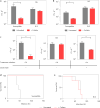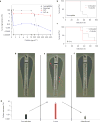Antibiotic failure mediated by a resistant subpopulation in Enterobacter cloacae
- PMID: 27572838
- PMCID: PMC5154748
- DOI: 10.1038/nmicrobiol.2016.53
Antibiotic failure mediated by a resistant subpopulation in Enterobacter cloacae
Abstract
Antibiotic resistance is a major public health threat, further complicated by unexplained treatment failures caused by bacteria that appear antibiotic susceptible. We describe an Enterobacter cloacae isolate harbouring a minor subpopulation that is highly resistant to the last-line antibiotic colistin. This subpopulation was distinct from persisters, became predominant in colistin, returned to baseline after colistin removal and was dependent on the histidine kinase PhoQ. During murine infection, but in the absence of colistin, innate immune defences led to an increased frequency of the resistant subpopulation, leading to inefficacy of subsequent colistin therapy. An isolate with a lower-frequency colistin-resistant subpopulation similarly caused treatment failure but was misclassified as susceptible by current diagnostics once cultured outside the host. These data demonstrate the ability of low-frequency bacterial subpopulations to contribute to clinically relevant antibiotic resistance, elucidating an enigmatic cause of antibiotic treatment failure and highlighting the critical need for more sensitive diagnostics.
Conflict of interest statement
The authors declare no competing financial interests.
Figures





Comment in
-
Bacterial pathogenesis: Populations drifting apart.Nat Rev Microbiol. 2016 Jul;14(7):402-3. doi: 10.1038/nrmicro.2016.78. Epub 2016 May 16. Nat Rev Microbiol. 2016. PMID: 27180938 No abstract available.
-
Antimicrobial resistance: Survival by reversible resistance.Nat Microbiol. 2016 May 26;1(6):16072. doi: 10.1038/nmicrobiol.2016.72. Nat Microbiol. 2016. PMID: 27572844 No abstract available.
References
-
- United States Centers for Disease Control and Prevention. Antibiotic Resistance Threats in the United States. 2013 http://www.cdc.gov/drugresistance/pdf/ar-threats-2013-508.pdf.
-
- Review on Antimicrobial Resistance. Antimicrobial Resistance: Tackling a Crisis for the Health and Wealth of Nations. 2014 http://go.nature.com/GLHVCr.
-
- Mezzatesta ML, Gona F, Stefani S. Enterobacter cloacae complex: clinical impact and emerging antibiotic resistance. Future Microbiol. 2012;7:887–902. - PubMed
Publication types
MeSH terms
Substances
Grants and funding
LinkOut - more resources
Full Text Sources
Other Literature Sources
Medical

